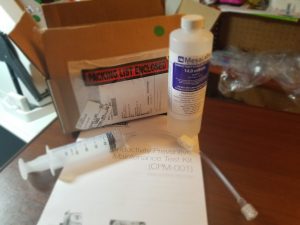The schlepping and stacking and priming and replacing of all the stuff associated with keeping the Cycler and Pureflow up and running is madness. I have absolutely no idea how anyone even slightly weaker or less competent than I—and I am seriously not competent—can manage.
Weekly Maintenance
The laundry list of things one must do to maintain the hardware–the Cycler and the Pureflow–grows. Reminders show up on the iPad at every treatment. Did you do this? This? This? At least a dozen items. Some are easy and routine, like cleaning the blood leak detector in the Cycler and cleaning the waste drain line on the Pureflow. Recommended monthly, I take care of those chores weekly. Routines are helpful.
The PAK
Then there is replacing the PAK. That happens every three months.
The PAK is a large black box, immensely heavy and difficult to wrangle. It connects to the water supply and purifies the water used for the dialysate. The old one must be removed and the new one installed and primed. When the PAK expires, nothing else can be done until it is replaced.
The process is difficult for anyone with adult-sized hands and utterly aggravating. I’ve done it three times now and every time I call Fresenius and have a tech walk me through it. If the PAK falls on your ankle, it also hurts like hell.
Keeping Conductivity Conductive
Sunday night as I was ready to cook up a batch of dialysate, the screen on the Pureflow informed me that I had 12 days to perform a Conductivity Preventative Maintenance. As though I had any idea what that might be. Item 7/10 in the manual was not helpful, but it did say to call Fresenius. Which I did. I got Ellie, who is one of the best techs, calm, sweet tempered, giggly. She told me I needed a kit—which a brief search proved I didn’t have. She put in an order for one and assured me it would arrive by Tuesday.
It arrived on time and I unpacked it, checked the list and read the directions such as they were. First thing was to ensure the bottle of “conductivity standard solution” (16 oz/475 ml of sodium chloride and deionized water) was at room temperature. Instructions said to set the bottle out overnight. Forget that. I put it on a windowsill in the sun and it was plenty warm in a few hours.
A Hand to Hold
Alerted to the fact that the test might take 45 minutes, I headed up to our dialysis room promptly after dinner. I laid out the bottle and syringe I had been sent, alongside the directions, and dialed Fresenius. Got Zack on the phone.
Not all techs are created equal. Despite my clear instructions that he was to treat me like a kindergartner of substandard intelligence, he plowed ahead assuming I understood everything he said. I reined him in and queried every instruction until I was sure what I was supposed to do. How full was the syringe supposed to be? Was the filled syringe to be connected to the tubing connected to the orange Conductivity Sensor Connector on the Control Unit or to the actual Conductivity Sensor Connector itself?
With some asperity, he confirmed that I needed 60 ml of solution and that the syringe should be attached to the actual connector. Okay. One step at a time, leaving out nothing.
Running the Test
The test took only a few minutes, not forty-five. Apparently warming the bottle in a puddle of sunshine was a good idea. When it was done I ended up with most of a bottle of solution and ended up calling MesaLabs in Colorado to find out if the stuff was safe to “discard” down the sink. A rather annoyed person at MesaLabs said, “it’s not toxic” as though there were no reason to imagine that any substance we handle in this day and age could possibly be toxic. I finally found the small print on the label that showed it was a sort of saline solution. So down the sink it goes.
Zen and the Art of Dialysis
I expected to carry out nursing skills. I quickly learned that inserting needles and monitoring blood pressure was the least of the responsibilities. But all one can do is have the techs walk you through it and find the chakra of calm, the heart chakra, the fourth primary chakra Anāhata that means “unhurt, unstruck, and unbeaten”.
We are still unbeaten.


